Image Degradation Using DEFLOW and Admitted to Black Sesame
Published:

Image Degradation Using DEFLOW

Model representation.
Deep learning methods on image enhancement tasks have already achieved good performance in academic area. They usually do experiments on synthetic data which includes paired degraded input images and clean ground truth. However, in real world, the degradation process is unknown, which means the synthetic data are far from the real data. Recently, many studies wanted to solve this problem. One of them, “DeFlow: Learning Complex Image Degradations from Unpaired Data with Conditional Flows” CVPR 2021 Oral, adopted an unsupervised learning method. They also released training code and pre-train model on GitHub https://github.com/volflow/DeFlow.
Content
- This note consists of 2 main tasks, including:
- Report describing the work on each task
- Resulting images of each task
- Train and test codes
- Report including:
- Algorithm
- Understanding of each task
- A briefing of algorithm
- Training/Fine-tune process summary for each task
- Pros and cons of the algorithm
- Innovation
- Result
- Show the objective metrics to measure the algorithm performance
- Image or plot to show the algorithm performance
- Analysis
- State process of each experiment which could improve performance
- Analyze the reason for any issue in the results
- Provide details of how to deal with abnormal situations found during training process.
TASK 1
Please understand the paper first. Then, you should use the released code to do training or fine-tune on the data of task I to perform X2 super resolution. Task1 data has 100 paired patches of size 512x512. You can only use input folder data as distribution reference to generate degradation data (you can use DIV2K as clean data, same as paper). Ground truth data only can be used by metrics to measure performance.
TASK 2
- First, you should do fine-tune model from task1 by using task2 data (120 frames of size 256X256 from real world data) to solve the real world X2 super resolution problem
- Second, in the paper, the authors introduced Domain Invariant Mapping Function h which helps to learn degradation. You need to design a new domain invariant function to retrain network, try to improve the performance of fine-tuning on task2, and explain your design and give an analysis for each domain invariant function performance.
- Please improve this degradation training approach, besides the domain invariant function.
QUESTION
Regarding super-resolution problems, we can also adopt many traditional algorithms to solve sampled issues. Here, you need to do research for any traditional approaches (it is usually a multi-frame system) for super-resolution, and state the following questions:
- The general algorithm pipeline of traditional methods(describe with flowchart).
- Pros and cons of traditional methods against deep-learning methods.
- Is it possible to design a SR pipeline combining both deep-learning and traditional methods to maximize the advantages? If so, draw a flowchart and explain the design. If not, why?




